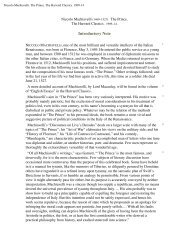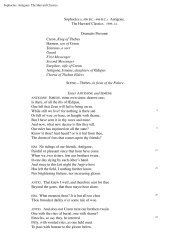Notre Dame de Paris - Bartleby.com
Notre Dame de Paris - Bartleby.com
Notre Dame de Paris - Bartleby.com
Create successful ePaper yourself
Turn your PDF publications into a flip-book with our unique Google optimized e-Paper software.
element to the view: that of a long belt of abbeys which bor<strong>de</strong>red almost its entire circumference from<br />
east to west; and, lying just insi<strong>de</strong> the fortified wall which encircled <strong>Paris</strong>, furnished a second internal<br />
rampart of cloisters and chapels. Thus, immediately adjoining the park of the Tournelles, between the<br />
Rue Saint-Antoine and the old Rue du Temple, stood the old convent of Sainte-Catherine, with its<br />
immense grounds, boun<strong>de</strong>d only by the city wall. Between the old and the new Rue du Temple was the<br />
Temple itself, a grim sheaf of lofty towers, standing haughty and alone, surroun<strong>de</strong>d by a vast, embattled<br />
wall. Between the Rue Neuve du Temple and the Rue Saint-Martin, in the midst of gar<strong>de</strong>ns, stood the<br />
Abbey of Saint-Martin, a superb fortified church, whose girdle of towers and crown of steeples were<br />
second only to Saint-Germain-<strong>de</strong>s-Prés in strength and splendour.<br />
Between the two streets of Saint-Martin and Saint-Denis stretched the convent enclosure of the Trinité,<br />
and between the Rue Saint-Denis and the Rue Montorgueil that of Filles-Dieu. Close by, one caught a<br />
glimpse of the moul<strong>de</strong>ring roofs and broken wall of the Cour <strong>de</strong>s Miracles, the only profane link in that<br />
pious chain.<br />
Lastly, the fourth area, standing out distinctly in the conglomeration of roofs on the right bank, and<br />
occupying the eastern angle formed by the city wall and the river wall, was a fresh knot of palaces and<br />
mansions clustered round the foot of the Louvre. The old Louvre of Philip Augustus, that stupendous pile<br />
whose enormous middle tower mustered round it twenty-three major towers, irrespective of the smaller<br />
ones, appeared from the distance as if encased within the Gothic roof-lines of the Hôtel d’Alencon and<br />
the Petit-Bourbon. This hydra of towers, this guardian monster of <strong>Paris</strong>, with its twenty-four heads ever<br />
erect, the tremendous ridge of its roof sheathed in lead or scales of slate and glistening in metallic lustre,<br />
furnished an unexpected close to the western configuration of the Town.<br />
This then, was the town of <strong>Paris</strong> in the fifteenth century—an immense mass—what the Romans called<br />
insula—of burgher dwelling-houses, flanked on either si<strong>de</strong> by two blocks of palaces, terminated the one<br />
by the Louvre, the other by the Tournelles, bor<strong>de</strong>red on the north by a long chain of abbeys and walled<br />
gar<strong>de</strong>ns all blen<strong>de</strong>d and mingling in one harmonious whole; above these thousand buildings with their<br />
fantastic outline of tiled and slated roofs, the steeples—fretted, fluted honey<strong>com</strong>bed—of the forty-four<br />
churches on the right bank; myriads of streets cutting through it; as boundary: on one si<strong>de</strong> a circuit of<br />
lofty walls with square towers (those of the University wall were round); on the other, the Seine,<br />
intersected by bridges and carrying numberless boats.<br />
Beyond the walls a few suburbs hugged the protection of the gates, but they were less numerous and<br />
more scattered than on the si<strong>de</strong> of the University. In the rear of the Bastille about twenty squalid cottages<br />
huddled round the curious stonework of the Croix-Faubin, and the abutments of the Abbey of<br />
Saint-Antoine <strong>de</strong>s Champs; then came Popincourt, buried in cornfields; then La Courtille, a blithe village<br />
of taverns; the market-town of Saint-Laurent with its church steeple appearing in the distance as if one of<br />
the pointed towers of the Porte Saint-Martin; the suburb of Saint-Denis with the vast enclosure of<br />
Saint-Ladre; outsi<strong>de</strong> the Porte-Montmartre, the Grange-Bâteliére encircled by white walls; behind that<br />
again, with its chalky slopes, Montmartre, which then had almost as many churches as wind-mills, but<br />
has only retained the wind-mills, for the world is now merely concerned for bread for the body. Finally,<br />
beyond the Louvre, among the meadows, stretched the Faubourg Saint-Honorè, already a consi<strong>de</strong>rable<br />
suburb, and the verdant pastures of Petite-Bretagne and the Marché-aux-Porceaux or pig-market, in the<br />
middle of which stood the horrible furnace where they seethed the false coiners.<br />
On the top of a hill, rising out of the solitary plain between La Courtille and Saint-Laurent, you will










